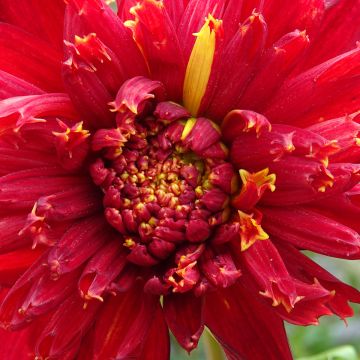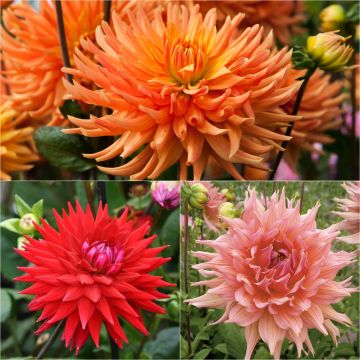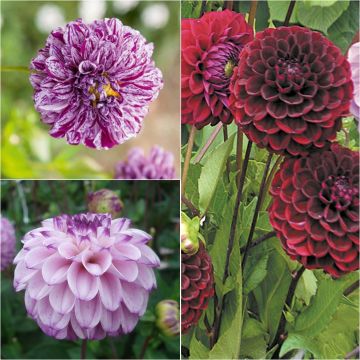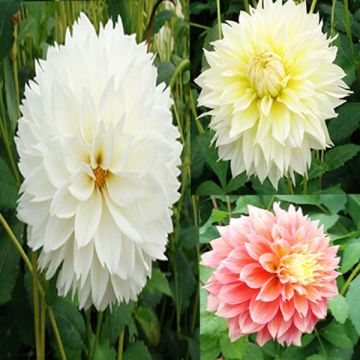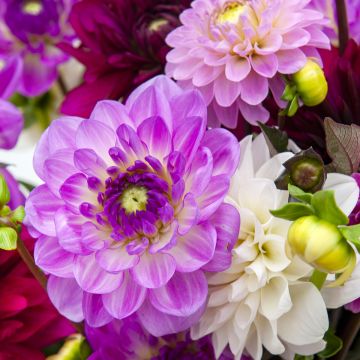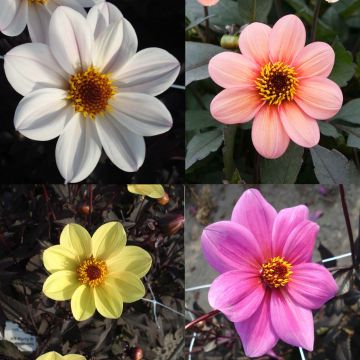Shipping country and language
Your country of residence may be:
Your country of residence is:
For a better user experience on our website, you can select:
Your shipping country:
Andorra
Austria
Belgium
Bulgaria
Canada
Chile
Croatia
Cyprus
Czechia
Denmark
Estonia
Finland
France
Germany
Greece
Hungary
Iceland
Ireland
Italy
Latvia
Lithuania
Luxembourg
Malta
Monaco
Netherlands
Poland
Portugal
Romania
Slovakia
Slovenia
Spain
Sweden
Switzerland
United Kingdom
We only deliver seed and bulb products to your country. If you add other products to your basket, they cannot be shipped.
Language:
French
German
Spanish
English
My Account
Hello
My wish lists
Plantfit
Log in / Register
Existing customer?
New customer?
Create an account to track your orders, access our customer service and, if you wish, make the most of our upcoming offers.


Dahlia Que Sera


Dahlia Que Sera


Dahlia Que Sera


Dahlia Que Sera
Dahlia Que Sera
Dahlia Que Sera
Dahlia
Very beautiful plant. That begins to bloom abundantly.
Julie, 22/08/2022
Why not try an alternative variety in stock?
View all →Order in the next for dispatch today!
Dispatch by letter from €3.90.
Delivery charge from €5.90 Oversize package delivery charge from €6.90.
More information
This item is not available in your country.
Schedule delivery date,
and select date in basket
This plant carries a 6 months recovery warranty
More information
We guarantee the quality of our plants for a full growing cycle, and will replace at our expense any plant that fails to recover under normal climatic and planting conditions.
From €5.90 for pickup delivery and €6.90 for home delivery
Express home delivery from €8.90.

Does this plant fit my garden?
Set up your Plantfit profile →
Description
The Dahlia 'Que Sera' is a variety of Dahlia with anemone flowers that will make a sensation in borders and bouquets due to the extreme refinement of its flowering which combines delicate colors and perfect form. Very double and delicately crumpled, the heads are unique with their large feathery-looking white center dotted with purple-violet, set on a quadruple collar striped with mauve and lavender on a white background. It blooms from summer until the first frost in sunny borders. A marvel to adopt in a romantic garden with penstemons, phlox, catmints...
Dahlias are tuberous plants from the large aster family, originally from the high plateaus of Mexico. Currently, the approximately 25,000 horticultural varieties obtained by humans have invaded gardens worldwide. Dahlias are classified according to the shape of their flowers. Introduced in 1998, 'Que Sera' is classified in the category of decorative Dahlias with anemone flowers. In this group, the colored ligules of the head are arranged in pompoms and surrounded by a collar of wider petals. In this variety, the well-developed heads are 10 to 15 cm (4 to 6in) in diameter and the outermost ligules are almost flat, arranged in a very double collar, striped with blueberry and washed with lavender. Those in the center are shorter, fringed, white tinged with violet-purple at the tip, tightly packed together like a large feathery cushion. The flowering takes place from the end of June to October. The vigorous plant will reach a height of 1 m (3ft) or more in fertile soil, with a bushy and dense habit. The highly branched stems are hollow and the leaves are opposite and divided into denticulate leaflets. The leaves and stems are a medium green.
To promote repeat flowering and extend the flowering period, take care to remove faded flowers. Even better, regularly compose attractive colorful bouquets by combining various varieties. Highlight the assertive character of this variety by associating it with fine grasses, Calamagrostis or Molinia. The flowering of cannas and Echinaceas is perfect to accompany that of Dahlias, as they occur simultaneously, as well as the flowering of cosmos or perennial salvias.
Dahlias are undoubtedly beautiful flowers and are a highlight in ornamental gardens, but they can also enhance vegetable gardens. In Mexico, this tuberous plant was initially cultivated as a root vegetable for consumption. Its poor taste qualities quickly assigned it the status of an ornamental plant. Since then, the interest in their beautiful exuberance has never waned.
Dahlia Que Sera in pictures


Plant habit
Flowering
Foliage
Botanical data
Dahlia
Que Sera
Asteraceae
Dahlia
Cultivar or hybrid
Other Dahlias
Planting and care
The 'Que Sera' Decorative Dahlia is easy to grow in all regions. For abundant flowering, following a few simple rules is good: plant the tubers in a sunny location after the last frost; rich, fresh and well-drained soils are perfect. However, stagnant moisture would promote tuber rot. Do not hesitate to amend the soil with compost and sand if necessary. Work the soil deeply and enrich it with blood, fish and bone. Place your tuber and crumble the soil well to fill without air pockets. Your dahlia should be covered with about 6 cm (2in) of soil. At the end of planting, water once abundantly and then regularly renew this watering during the first six weeks to help with rooting. Dahlias are sensitive to cold; they need to be overwintered. In November, the first frosts cause the foliage to blacken; it is time to dig them up. Carefully unearth the tubers. Remove as much soil as possible. Let the foliage dry so that the tubers can replenish their reserves. Then cut the stems to 10 cm (4in). Spread your bulbs in a box of newspaper. Store them away from frost in a dry, cool, dark place, such as a frost-free garage or attic. In milder regions experiencing only a few days of frost per year, it is possible to leave them in place. In this case, cover the ground with a layer of leaves or straw for protection.
This variety, with its tall stems, often requires staking.
Planting period
Intended location
Care
- , onOrder confirmed
Reply from on Promesse de fleurs
Haven't found what you were looking for?
Hardiness is the lowest winter temperature a plant can endure without suffering serious damage or even dying. However, hardiness is affected by location (a sheltered area, such as a patio), protection (winter cover) and soil type (hardiness is improved by well-drained soil).

Photo Sharing Terms & Conditions
In order to encourage gardeners to interact and share their experiences, Promesse de fleurs offers various media enabling content to be uploaded onto its Site - in particular via the ‘Photo sharing’ module.
The User agrees to refrain from:
- Posting any content that is illegal, prejudicial, insulting, racist, inciteful to hatred, revisionist, contrary to public decency, that infringes on privacy or on the privacy rights of third parties, in particular the publicity rights of persons and goods, intellectual property rights, or the right to privacy.
- Submitting content on behalf of a third party;
- Impersonate the identity of a third party and/or publish any personal information about a third party;
In general, the User undertakes to refrain from any unethical behaviour.
All Content (in particular text, comments, files, images, photos, videos, creative works, etc.), which may be subject to property or intellectual property rights, image or other private rights, shall remain the property of the User, subject to the limited rights granted by the terms of the licence granted by Promesse de fleurs as stated below. Users are at liberty to publish or not to publish such Content on the Site, notably via the ‘Photo Sharing’ facility, and accept that this Content shall be made public and freely accessible, notably on the Internet.
Users further acknowledge, undertake to have ,and guarantee that they hold all necessary rights and permissions to publish such material on the Site, in particular with regard to the legislation in force pertaining to any privacy, property, intellectual property, image, or contractual rights, or rights of any other nature. By publishing such Content on the Site, Users acknowledge accepting full liability as publishers of the Content within the meaning of the law, and grant Promesse de fleurs, free of charge, an inclusive, worldwide licence for the said Content for the entire duration of its publication, including all reproduction, representation, up/downloading, displaying, performing, transmission, and storage rights.
Users also grant permission for their name to be linked to the Content and accept that this link may not always be made available.
By engaging in posting material, Users consent to their Content becoming automatically accessible on the Internet, in particular on other sites and/or blogs and/or web pages of the Promesse de fleurs site, including in particular social pages and the Promesse de fleurs catalogue.
Users may secure the removal of entrusted content free of charge by issuing a simple request via our contact form.
The flowering period indicated on our website applies to countries and regions located in USDA zone 8 (France, the United Kingdom, Ireland, the Netherlands, etc.)
It will vary according to where you live:
- In zones 9 to 10 (Italy, Spain, Greece, etc.), flowering will occur about 2 to 4 weeks earlier.
- In zones 6 to 7 (Germany, Poland, Slovenia, and lower mountainous regions), flowering will be delayed by 2 to 3 weeks.
- In zone 5 (Central Europe, Scandinavia), blooming will be delayed by 3 to 5 weeks.
In temperate climates, pruning of spring-flowering shrubs (forsythia, spireas, etc.) should be done just after flowering.
Pruning of summer-flowering shrubs (Indian Lilac, Perovskia, etc.) can be done in winter or spring.
In cold regions as well as with frost-sensitive plants, avoid pruning too early when severe frosts may still occur.
The planting period indicated on our website applies to countries and regions located in USDA zone 8 (France, United Kingdom, Ireland, Netherlands).
It will vary according to where you live:
- In Mediterranean zones (Marseille, Madrid, Milan, etc.), autumn and winter are the best planting periods.
- In continental zones (Strasbourg, Munich, Vienna, etc.), delay planting by 2 to 3 weeks in spring and bring it forward by 2 to 4 weeks in autumn.
- In mountainous regions (the Alps, Pyrenees, Carpathians, etc.), it is best to plant in late spring (May-June) or late summer (August-September).
The harvesting period indicated on our website applies to countries and regions in USDA zone 8 (France, England, Ireland, the Netherlands).
In colder areas (Scandinavia, Poland, Austria...) fruit and vegetable harvests are likely to be delayed by 3-4 weeks.
In warmer areas (Italy, Spain, Greece, etc.), harvesting will probably take place earlier, depending on weather conditions.
The sowing periods indicated on our website apply to countries and regions within USDA Zone 8 (France, UK, Ireland, Netherlands).
In colder areas (Scandinavia, Poland, Austria...), delay any outdoor sowing by 3-4 weeks, or sow under glass.
In warmer climes (Italy, Spain, Greece, etc.), bring outdoor sowing forward by a few weeks.
